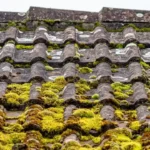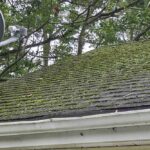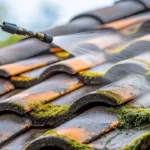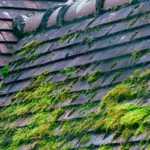Roof moss home remedy effectiveness is a topic that intrigues many homeowners. With the rise of DIY solutions, it’s important to understand whether these remedies are truly effective for keeping your roof moss-free. This article aims to explore various home remedies, their effectiveness, and practical tips for maintaining your roof.

Understanding Roof Moss Growth
Before diving into remedies, it’s crucial to understand why moss grows on roofs. Moss thrives in damp and shaded environments, making rooftops with overhanging trees and poor sunlight exposure perfect breeding grounds. This growth not only affects the aesthetic appeal of your home but can also lead to structural damage over time.
Common Home Remedies for Roof Moss
Several home remedies are touted for their ability to remove moss from roofs. Let’s explore some popular options:
Baking Soda Solution
Baking soda is a common household item that many claim can kill moss due to its high pH levels. To use it, mix baking soda with water and spray it directly onto the mossy areas.
Vinegar Mixture
Vinegar, known for its acidity, can be effective in removing moss. A simple mixture of vinegar and water can be applied to the affected areas. The acid in vinegar helps kill the moss while being a natural alternative to chemical solutions.
Soap Detergent Method
Dish soap or laundry detergent can break down the moss structure, making it easier to remove. Mixing soap with water and applying it with a sprayer can be a straightforward solution.
How Effective Are These Remedies?
The effectiveness of these home remedies varies. While they can help in temporarily removing moss, they might not always prevent regrowth. Factors like climate, roof material, and moss severity play significant roles in determining the success of these methods.
Benefits of Using Home Remedies
Home remedies are cost-effective and utilize readily available materials. They are an environmentally friendly option compared to chemical treatments. Moreover, they reduce the need for professional intervention, allowing homeowners to maintain their roofs independently.
Limitations of Home Remedies
However, these remedies might not be suitable for severe moss infestations. In such cases, professional cleaning might be necessary. Home remedies often require multiple applications and regular maintenance to be effective.
Comparing DIY and Professional Solutions
While DIY solutions provide a hands-on approach, professional cleaning services offer comprehensive treatments that ensure long-lasting results. [Roof Moss DIY vs Professional Cleaning](https://roof-home.com/roof-moss-diy-vs-professional-cleaning/) discusses the advantages and disadvantages of each method.
Maintaining Your Roof Post-Moss Removal
After removing moss, it’s vital to adopt proactive measures to prevent regrowth. Regular cleaning, trimming overhanging branches, and ensuring proper drainage are essential steps. For more tips, refer to [How to Maintain Roof After Moss Removal](https://roof-home.com/how-to-maintain-roof-after-moss-removal/).
Preventive Measures to Consider
Preventive measures are crucial for maintaining a moss-free roof. Installing zinc or copper strips can help as they release substances that prevent moss growth. Regular inspections and cleaning can also ensure early detection and treatment of moss.
The Role of Climate in Moss Growth
Climate plays a pivotal role in moss growth. Regions with high humidity and frequent rain are more prone to moss infestations. Understanding your local climate can aid in selecting the right preventive measures.
Moss vs. Algae: What’s the Difference?
It’s essential to distinguish between moss and algae as they require different treatment methods. Moss is a plant-like organism, while algae are more similar to fungi. For more information, visit [Roof Moss vs Algae Stains](https://roof-home.com/roof-moss-vs-algae-stains/).
Eco-Friendly Alternatives to Chemicals
As environmental consciousness grows, many homeowners seek eco-friendly solutions. Natural remedies like baking soda and vinegar are sustainable options that minimize chemical usage.
When to Seek Professional Help
If home remedies fail to control moss growth, it might be time to consult professionals. They offer specialized treatments tailored to your roof’s needs, ensuring effective removal and prevention of moss.
Cost Considerations for Moss Removal
Cost is a significant factor for homeowners. Home remedies are generally more affordable, but professional services can offer more permanent solutions. Weighing the pros and cons of each approach is essential for informed decision-making.
Exploring the Long-Term Impact of Moss
Moss can lead to significant roof damage if left untreated. It can trap moisture, leading to rot and decay. Understanding these long-term impacts emphasizes the importance of regular roof maintenance.
Future Trends in Roof Cleaning
The roof cleaning industry is evolving, with new technologies and eco-friendly solutions emerging. Staying updated with these trends can help homeowners make informed decisions regarding roof maintenance.
Conclusion: Making an Informed Choice
In conclusion, roof moss home remedy effectiveness depends on various factors. While home remedies offer a cost-effective and eco-friendly option, their success varies based on the severity of the moss problem and local conditions. For severe cases, professional help might be necessary to ensure comprehensive removal and prevention. By understanding the pros and cons of each approach, homeowners can make informed decisions that best suit their needs.

FAQs
Can home remedies permanently remove roof moss?
Home remedies can help in removing roof moss temporarily, but they often require regular maintenance to prevent regrowth.
Are professional moss removal services worth it?
Yes, professional services offer comprehensive solutions that ensure effective removal and long-term prevention of moss.
What are the environmental benefits of using home remedies?
Home remedies are eco-friendly alternatives that minimize the use of harsh chemicals, making them a sustainable choice for homeowners.
This article contains affiliate links. We may earn a commission at no extra cost to you.








